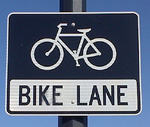
A few years ago, I was biking up a hill under a heavy backpack that was brimming with groceries, when I saw a car temporarily abandoned in my bike lane. Presumably this car’s unfortunate parking-spot seeker was just inside the nearby convenience shop picking up a carton of almond milk or whatever and would “only be a second”. I looked over my shoulder and saw that traffic was sufficiently behind me that I would have time to pass in the lane of travel to the left, even in my current grocery-laden uphill-facing condition, and so I commenced passing. However, as I reached the other side of the parked car and started heading back into my designated zone, an SUV full of teenage girls whizzed past me as its occupants shouted angrily at me and showed me all of their middle fingers. I had apparently not anticipated, as I calculated my chances for getting around the parked car in time, that one of those cars off in the multi-laned distance was going twice the speed limit and was making a beeline for the space I would be occupying. My bad!
The next day, I recounted this story to a friend of mine and then began whining about all the drivers out there who feel it’s OK to store their cars in the bike lane, to which my lovely non-cyclist friend replied, “Well, to be honest, until now I’d thought of the bike lane as the Do Whatever You Want Lane.” In her defense, the police in San Francisco seem to have a similar attitude, so I can see where she might have become confused.
So, to clarify for anyone who might not understand why cyclists get grumpy when the bike lane is blocked, here are a few typical bike lane situations that really get our Pedal Panties in a knot.
A blocked bike lane adjacent to high speed traffic
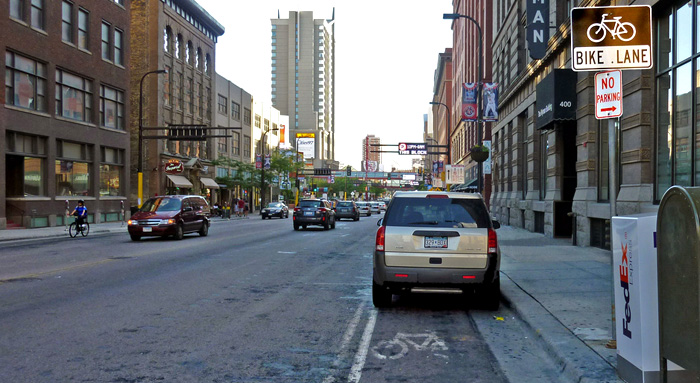
Photo adapted from one taken by Payton Chung
If a cyclist is forced to leave the bike lane and merge suddenly into high speed traffic, several things conspire to make this a very dangerous situation for the cyclist:
- Beyond a distance of twenty or thirty feet, humans (yes, even cyclists) are terrible at judging the distance of an object. (For a little perspective, a city block ranges in size from about 300 to 900 feet.) As Tom Vanderbilt explains in chapter three of his wonderful New York Times Best Seller, Traffic,
“When objects like cars are within twenty or thirty feet, we’re good at estimating how far away they are, thanks to our binocular vision…. Beyond that distance, both eyes are seeing the same view in parallel, and so things get a bit hazy. The farther out we go, the worse it gets: For a car that is twenty feet away, we might be accurate to within a few feet, but when it is three hundred yards away, we might be off by a hundred yards.
- Especially when viewing an approaching object more-or-less straight on, humans are equally terrible at judging how fast it is closing in on us. In the same chapter, Mr. Vanderbilt discusses this problem in the context of one car trying to pass another on a two-lane bi-directional road:
“A car in the distance approaching at 20 miles per hour makes passing easy, but what if it is doing 80 miles per hour? The problem is this: We cannot really tell the difference. Until, that is, the car gets much closer–by which time it might be too late to act on the information.”
- As the famous Invisible Gorilla experiment shows, people very often don’t see things they are not looking for. When we are driving cars, in order to be able to navigate our environment at higher speeds than we are evolved to handle, we select out any input that is not “useful” to us. As we move at higher and higher speeds, we filter out more and more of the information around us.
Therefore, as sudden unexpected entities on the road, especially a high-speed road, cyclists merging from an obstructed bike lane cannot count on the motorists behind them to help prevent disaster. The most common reason given by drivers for colliding with cyclists is that they looked but didn’t see them, regardless how many lights or reflectors the cyclists were wearing.
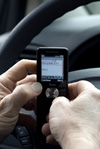
Photo from OregonDOTThe selective vision problem is obviously aggravated by driving while drunk, exhausted, or distracted by things like GPS devices, smart phones, regular phones, tacos, Facebook, spiders (just talking about spiders will cause an arachnophobe to tunnel their vision), or even distractions outside of the car, like ghosts, UFOs, attractive pedestrians, the walking dead, anti-everything protests, or pedestrians wearing nothing but paint. And no, using a hands-free phone is not safer.
- And finally, what should be blindingly obvious to everybody: In the event of a collision, the higher the speed upon impact, the higher the victim’s chances of dying or being seriously injured are. What is perhaps not as evident, though, is that the human body cannot tolerate impacts much over 20mph and the risk of death increases with speed non-linearly. If you are hit at 20mph, your chances of survival are around 97%. If the speed is increased by just 10mph, your chance of survival drops dramatically to 1 in 5. For this reason, councils all over England are dropping their speed limits to 20mph in residential areas and school zones. Tom Vanderbilt puts it another way in chapter 9 of my favorite book ever this week:
“In a crash at 50 miles per hour, you’re fifteen times more likely to die than in a crash at 25 miles per hour — not twice as likely, as you might innocently expect from the doubling of the speed. The relationships are not proportional but exponential.”
Bicycle commuters may not have all of this calculus in their heads to back up the middle finger they wave at you while you idle your car in their bike lane, but they instinctively perceive the danger they are in from the collection of near misses they all have from their experience on the road, and they resent being put so blatantly and casually in harm’s way.
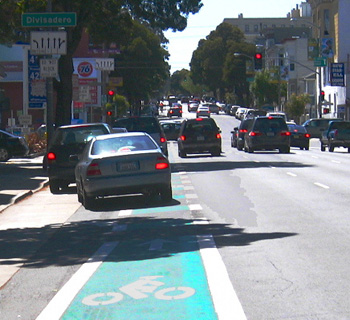
The Fell street bike lane westbound by Divisadero
(Photo adapted from one taken by Jim Dyer)
If you are a San Franciscan, you are hopefully familiar with the continuing battle to make three blocks of Fell Street safer, particularly at the corner of Divisadero, where the bike lane is chronically blocked by patrons of the Arco/BP station. This is a high speed corridor with an unprotected bike lane that is perpetually blocked by motorists. The Fell Street bike lane is very heavily travelled by cyclists as the connector between the Wiggle and the Panhandle. It is crucial that San Francisco act decisively to fix this section of the flattest and otherwise safest cross-town bicycle route from the bay to the beach.
A blocked bike lane on an incline
In light of all of the points above, it should be clear now why blocking an uphill bike lane is similarly badly received by cyclists. Riding up hill on a bike is harder and therefore slower than riding on a flat surface or on a descent. When you block our lane on an incline, we are forced to merge with traffic while going painfully slow in comparison. The speed differentials are all out of whack and make for conditions similar to those on a higher speed road. (I am going to trust that I don’t need to include a separate section for bike lanes on high speed uphill roads.)
Random city equipment blocking the bike lane
Nothing says I love you like a piece of DOT equipment in the bike lane.
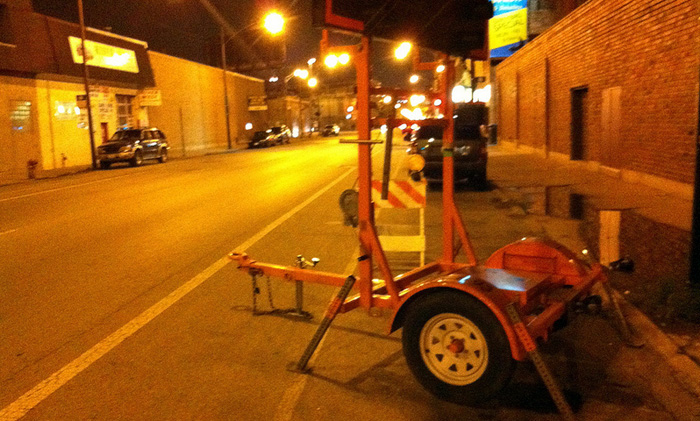
(Photo adapted from one taken by Adam Herstein)
Civilian crap blocking the bike lane
According to a major study conducted by UCLA professor Donald Shoup, United States residents (regardless if they drive a car or not) subsidize curbside parking as much as they subsidize Medicare or national defense. Free and cheap street parking also brings with it a number of other unsavory externalities I will one day cover in a different post, but keeping these things in mind, it should now be clear why it is so vexing for tax paying cyclists to discover that their own neighbors feel entitled not only to the curbside space reserved for their cars but also to the cyclist’s lane of travel whenever they need a bit of extra free storage for their garbage bins or whatever. Blatantly prioritizing your own convenience over someone else’s safety is usually to risk getting a rise out of them.
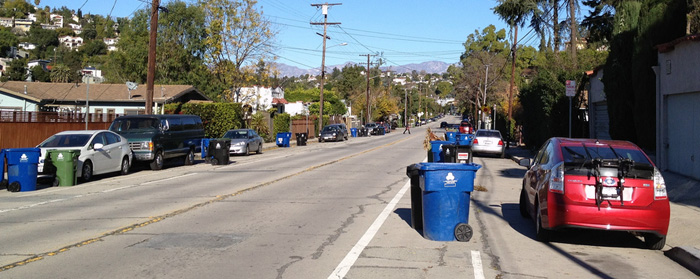
Sorry for biking in your trash lane
(Photo and caption by Eric Gelinas)
Ironic lane blocking
Bike commuters often feel like nobody in the world understands their needs or recognizes their rightful place on the road. And nothing drives the point home better than an ironically blocked bike lane.
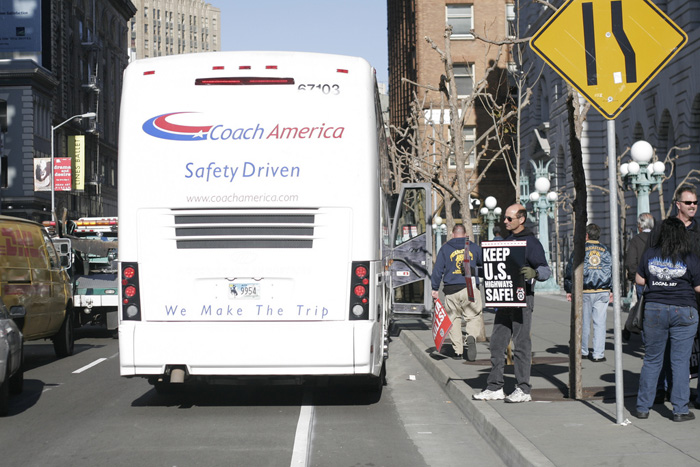
Safety Driven
(Photo by Kate McCarthy)
Click here to see the most ironically blocked bike lane in the whole world. Ohhh Emmm Geee. And of course, a traffic cop parked in the bike lane is a timeless classic, especially when that cop is simultaneously issuing tickets to cyclists as they leave the bike lane to go around him, which is of course, not illegal.
Traitorous lane blocking
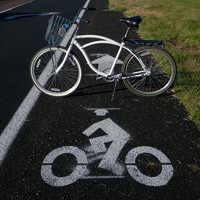
Photo by Daniel OinesBefore you start suspecting that cyclists are made 100% of saccharin and sunshine, let me call to your attention the harsh reality that some cyclists, much like their car-driving counterparts (or perhaps like themselves when they are in cars rather than on bikes), don’t realize other cyclists exist. A few cyclists, especially beginner bikers and vacation bikers, have an annoying tendency to abandon their bikes in the lane or stand around in the lane exploring a bike map with their friends. A still more irksome form of cannibalistic lane blocking is salmoning, a practice brought on by the preponderance of wide blocks combined with multi-lane one-way arterials in American cities, motivating lazy cyclists to cheat by going the wrong way down a bike lane.
Partial blocking of a bike lane
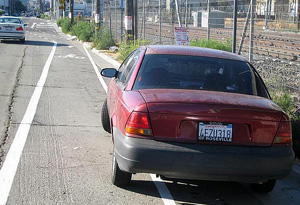
Photo by shmoothCyclists can feel the compassion like a kick in the teeth when they see a car partially blocking the lane. You can almost hear the driver feeling good about themselves: I’m not blocking very much of the lane. Bikes aren’t that big! I’m sure they can get by! They totally won’t mind.
If you know a thing or two about bikes and car doors, you know the part of a bike lane that is safe from car doors is the left-most 6 inches or so of most bike lanes, if indeed any portion of it is safely ridable, which makes it easy to see why a lane encroached upon from the right will cause most safety-conscious cyclists to veer into the lane of travel to get around all those good intentions. Similarly, a bike lane partially blocked from the right side by a cab or a delivery vehicle, looks uncannily like a death trap to an experienced, risk-averse cyclist.
Minivans, SUVs, and luxury vehicles blocking the bike lane
Undoubtedly not all cyclists are as cynical or as smug as I am, but when I see a minivan, an SUV, or a luxury vehicle blocking my bike lane, I assume one of two things is going on:
- The driver of the vehicle hails from the suburbs, drives their car every day, and has possibly never ridden a bike in their life. They probably live much of their lives in pursuit of safety for themselves and their kin while being content to throw the rest of us under the bus. As the target market for this hands free home paper towel dispenser, it’s likely they think germs and terrorists are the biggest dangers they face in their daily lives, so they’re far too busy making a stand for clean hands to think about the safety of other road users.
- OR the driver is not ignorant at all of what they are putting the rest of us through, they simply suffer from a completely unchecked sense of entitlement to take up whatever space suits their fancy in the moment.
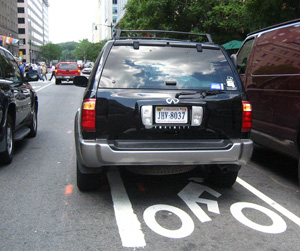
Photo by Timothy Vollmer

Photo by EURIST e.V.
And in case anyone is wondering, despite the obvious lack of enforcement, yes blocking a bike lane is illegal in San Francisco and in the state of California. However, taxi cabs have been given a break by the SFMTA. As it happens, the one time I’ve been hit by a car at high speed, it was while I was passing a group of taxis and Ubers all bunched up in the bike lane to pick up the responsible non-driving drunks outside of Pete’s Tavern. If only the drunk driver behind me had decided to take a cab that night.
Unless otherwise noted, all photos used in this post are licensed as part of the Creative Commons

Would you call this one ironic lane blocking or traitorous lane blocking? That’s a van moving bike share bikes around for rebalancing.
https://twitter.com/gregbilling/status/225710233371148288/photo/1
Apparently the line between ironic and traitorous lane blocking can be a fine one. I’m stumped on this one. I would be *sorely* tempted just to ride right into this obstacle, though, and wind up in the back of the van. So maybe this one belongs in a new category: Choose Your Own Adventure lane blocking!
That ramp is *so* handy, after all.
Love your content so far, BTW. Great job.
Pingback: Cyclelicious » The multipurpose bike lane